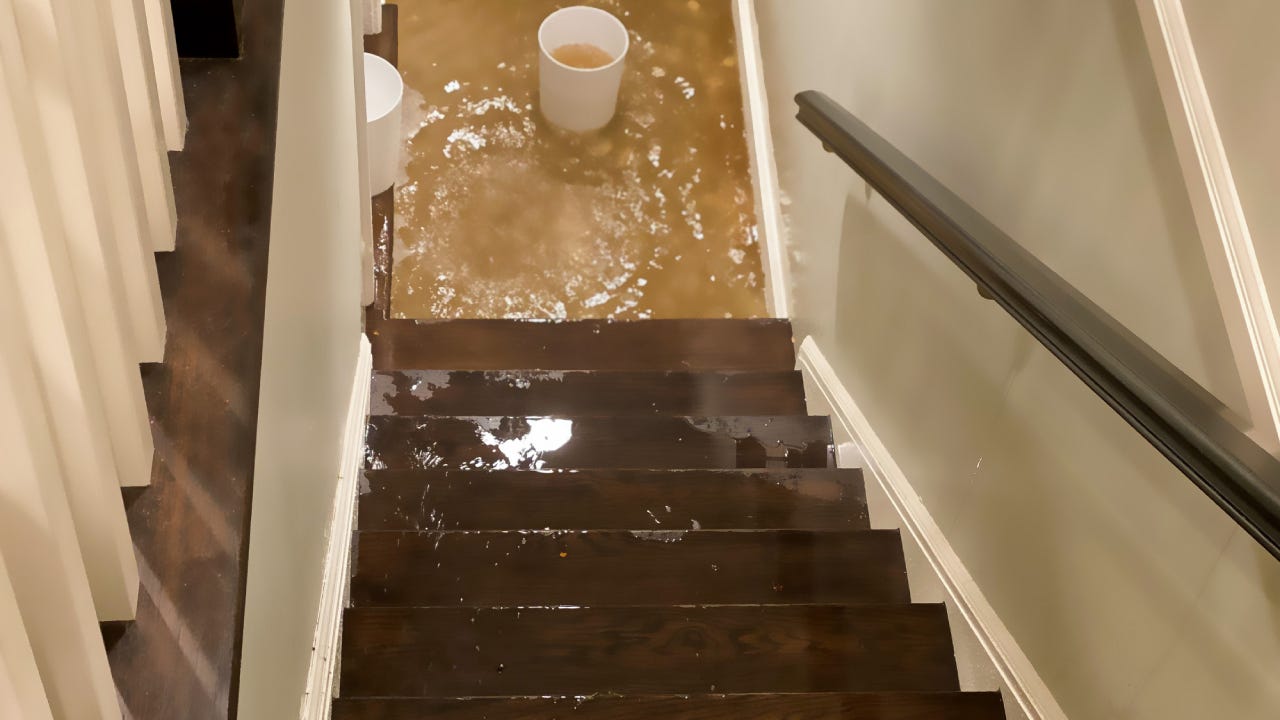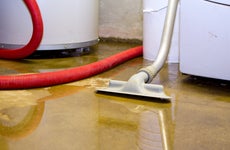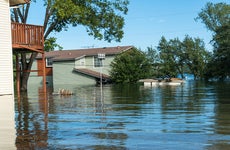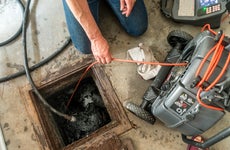Does homeowners insurance cover basement flooding?

The Bankrate promise
At Bankrate, we strive to help you make smarter financial decisions. To help readers understand how insurance affects their finances, we have licensed insurance professionals on staff who have spent a combined 47 years in the auto, home and life insurance industries. While we adhere to strict , this post may contain references to products from our partners. Here's an explanation of . Our content is backed by Coverage.com, LLC, a licensed entity (NPN: 19966249). For more information, please see our .
Our writers and editors used an in-house natural language generation platform to assist with portions of this article, allowing them to focus on adding information that is uniquely helpful. The article was reviewed, fact-checked and edited by our editorial staff prior to publication.
Even if your home is not located near a body of water, your property may still be at risk for flooding. Basements can be particularly susceptible to flooding because they are below ground. And as extreme weather becomes more common, heavy rainfall and flash floods pose a risk to areas that previously were rarely touched by these problems. You might assume that your homeowners insurance policy covers basement flood damage, but it depends on what causes the flooding. Standard home insurance policies exclude most flood damage, including flooding from storm surges, rainfall, snowmelt and sewer backup.
Find out when and how your home policy may cover basement flooding.
When does homeowners insurance cover basement flooding?
Basement flooding can be caused by a number of things. Your homeowners insurance policy might cover some of these situations but not others. Standard HO-3 policies exclude flooding caused by rain, storm surges, sewer backup and snowmelt, but they may cover basement flooding in some specific circumstances. The following perils are usually named under dwelling coverage in an HO-3 policy and not excluded from your personal property coverage.
Burst pipes
If your basement floods because a pipe bursts during a freeze or the pipe to your washing machine breaks, the resulting damage will most likely be covered by your home insurance policy. However, there are a few caveats to keep in mind:
- You need to be living in the home.
- You need to be keeping your home at a minimum livable temperature (usually above 60 degrees).
- You need to be properly maintaining your home.
If your insurer discovers that the burst pipe is the result of negligence or lack of maintenance, it will likely deny your claim.
Broken appliances
When an appliance like a washing machine or dishwasher malfunctions, the resulting water damage is usually covered by homeowners insurance. As long as the breakdown wasn’t caused by neglect or improper maintenance, your policy should cover the damage.
Let’s say your water heater springs a leak and you discover flood damage in your basement as a result. The damage would likely be covered by your home insurance policy unless the heater turns out to be poorly maintained or the leak has been gradual or ongoing. Your claim may even be denied if your water heater was very old and should have been replaced before the leak occurred.
Localized overflow
In the event of localized overflow, such as a bathtub or sink overflowing, homeowners insurance typically provides coverage. This is considered a sudden and accidental event, and as long as it’s not due to negligence, your policy should cover the damages.
However, if your insurer can show that the flood was the result of a continuing maintenance problem, your claim could be denied.
So, for example, if your toilet habitually overflows because of a blockage that you haven’t fixed, you may not receive a payout. Additionally, some home policies exclude this type of scenario from coverage. It’s best to review your policy and talk with your insurance agent to determine what kind of overflows are covered in your home insurance. Shop around and ask for quotes from insurance companies to compare coverage types and costs to make sure that you are protected.
When does homeowners insurance not cover basement flooding?
There are some times when standard home insurance policies won’t cover water damage to a basement, some of which may be surprising. We’ve broken down some of these scenarios and what type of coverage you might want to consider if you’re worried about any of these happening to you.
Natural flooding
Homeowners insurance does not cover flooding resulting from hurricanes, heavy rains, snowmelt, runoff or other natural causes. For this coverage, you would need to add a separate flood insurance policy or endorsement to your home policy.
Flooding is more common than you may think. The Federal Emergency Management Agency (FEMA) reports that more than 25 percent of U.S. flood insurance claims are filed by homeowners who live outside of high-risk areas. Even if you don’t live in a high-risk zone, flood insurance may be worthwhile. Flood insurance is available through the National Flood Insurance Program (NFIP) and select private carriers. If you purchase a home in a flood zone, your mortgage holder may require you to carry a flood policy.
Sump pump backups
Standard homeowners insurance policies generally exclude water that backs up through sewers or drains or overflows from a sump pump. However, you may be able to add a water backup coverage endorsement to your policy to cover these events. Not all carriers offer water backup endorsements, so if this is critical to you, you should inquire about this coverage type during the quoting process.
Sewer backup
This one is a little tricky. Say there is a backup in your basement caused by your washing machine or another appliance. In that case, you will likely be covered, as noted above. However, if the flooding is the result of an external sewer backing up, involving outside pipes that may not even be on your property, it typically will not be covered.
This is another area where many homeowners insurance companies offer sewer backup insurance, typically as an endorsement, to add coverage to your policy. Since sewer backups can be very expensive, it may be a worthwhile add-on if your carrier offers it. Typically, this coverage is purchased with the same endorsement that covers sump pump backups.
Seepage issues
Homes with cracked foundations or those built on top of ground with high water tables may experience basement flooding due to seepage. Water seeping into your basement because of cracks in your foundation or poor landscaping drainage is not usually covered by homeowners insurance. This is usually considered a maintenance issue, which falls under the responsibility of the homeowner and would not be covered under your policy.
Maintenance or neglect
Damage caused by neglect or lack of maintenance is not covered by homeowners insurance. This includes things like old, rusty pipes that burst or leak, or aging appliances that fail.
If your insurer can prove that you were negligent in caring for your home and its belongings and that your lack of care caused the flood, you would be out of luck. Your claim might also be denied if you saw a leak and didn’t mitigate the water damage in a timely manner.
What coverage types will cover basement flooding?
Endorsements increase the cost of your homeowners insurance, but they may be worthwhile for added financial protection from water damage. Although not all carriers offer every endorsement type, you could inquire about the following during the quoting process if you’re concerned about water damage or flooding in your home.
- Flood insurance: Flood insurance comes as a separate policy, usually through the NFIP or a private insurer. If your home is in a flood zone, you have repeated problems with flooding or you feel your property is at risk of flooding, you may want to strongly consider purchasing a flood insurance policy. It may even be required by your mortgage company.
- Water backup coverage: This is an optional coverage that can be added to your primary homeowners policy. It is designed to cover you for water damage caused by a drain or sump pump backup.
- Service line coverage: Service line coverage is an endorsement that covers utility pipes, like water and sewer lines, if they cause damage to your home. This endorsement may be beneficial, as damage to utility lines can cause flooding in and around your home.
- Contents replacement cost coverage: If you store personal items in your basement, you might consider adding a replacement cost coverage endorsement to your home insurance policy. Most HO-3 policies cover personal property on an actual cash value basis, meaning you might be left with out-of-pocket costs if basement flooding damages your belongings.
- Equipment breakdown coverage: If your washing machine breaks and floods your basement, the flood damage will typically be covered, but the cost of a new washer will not be. Equipment breakdown coverage pays to repair or replace home appliances and systems if they malfunction unrelated to a covered peril.
How to mitigate basement flood risk
Basement flooding poses a significant risk to homeowners, causing damage to property and potentially leading to costly repairs while rendering part of your home uninhabitable. There are some proactive measures homeowners can take to mitigate this risk and safeguard their basements from flooding and minimize the likelihood of damage from excess water.
Here are some key steps to reduce basement flood risk:
- Ensure proper grading around the foundation to direct water away and prevent pooling.
- Install and maintain a functional sump pump system to remove excess water.
- Seal cracks in the foundation walls to prevent water seepage.
- Direct gutter downspouts away from the foundation and extend them to ensure proper drainage.
- Consider installing a backwater valve to prevent sewage backup during heavy rainfall.
Frequently asked questions
-
-
You can find out if your home is situated in a FEMA-designated flood zone by inputting your address into FEMA’s flood map search tool. If your home is located in a flood zone, your lender will likely require you to carry a flood insurance policy. Even if you are not required to, homeowners in high-risk areas may benefit from the financial protection flood coverage offers.
-
Yes, if you file a claim for basement water damage and it gets approved, you can generally expect your insurance rate to increase. This is also the case with flood insurance claims, whether you have a policy through the NFIP or a private carrier. Even if you have a flood claim and it gets denied, your premium could still increase, and you will also be responsible for paying for the repairs out of pocket. This is because home insurance companies see homeowners who file claims as more likely to file further claims in the future, increasing their perceived risk to the company.
-
Even if it’s not required for your property, you can still purchase flood insurance. Flood damage can be devastating, so even if you live in a moderate-risk area, coverage could still be a smart financial decision. Speaking with a licensed insurance agent about your home’s specifics may help you make a more informed decision on whether to purchase flood insurance.
-
No, a standard home insurance policy will not cover basement flooding due to heavy rainfall. For coverage, you would need to purchase a separate flood insurance endorsement or policy.
-
Related Articles



